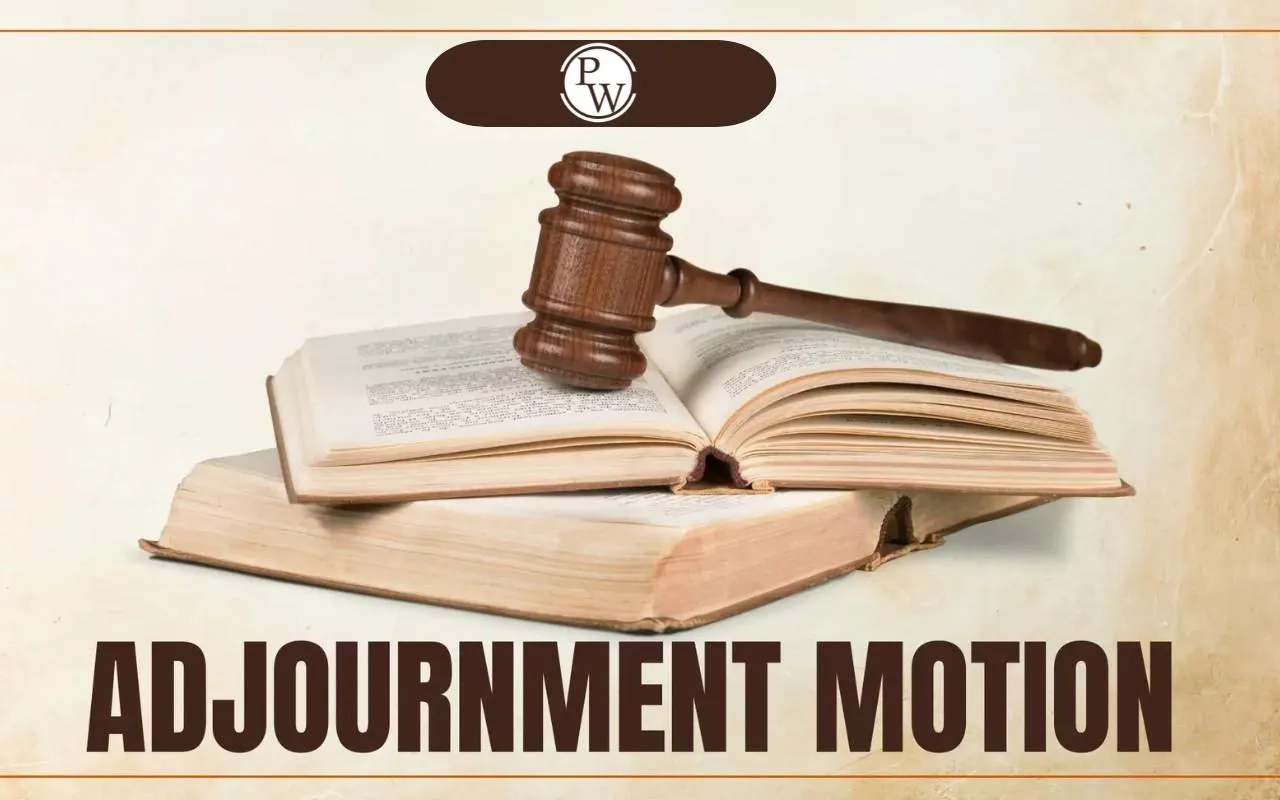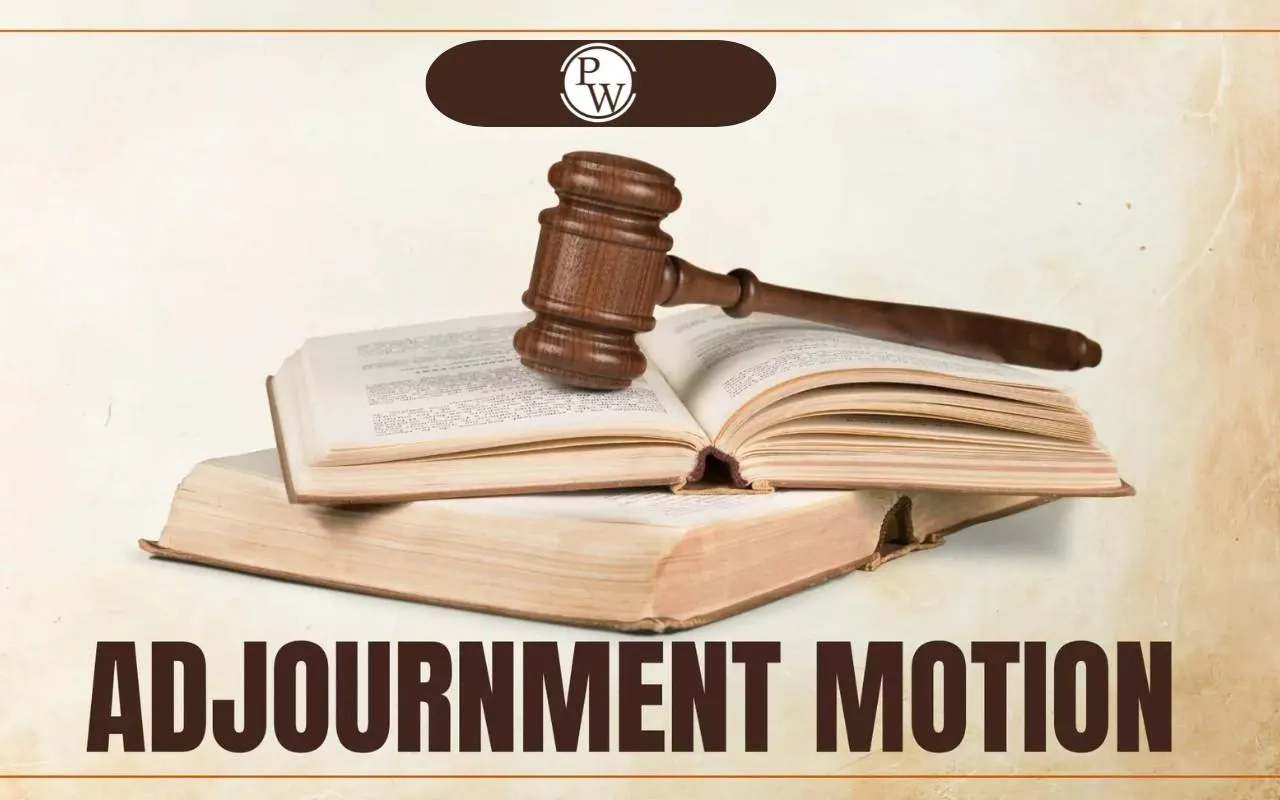

Adjournment Motion is an essential parliamentary procedure that is used to interrupt the normal business of the House and draw attention to a definite matter of urgent public importance. Its adoption signifies a strong element of censure against the government, which makes it a unique and significant tool for accountability in India’s parliamentary democracy.
This guide will detail the meaning, criteria, and procedure for the Adjournment Motion , along with its importance in governance. We will also explore its rules and compare them with other types of parliamentary motions, enhancing understanding for UPSC aspirants and the general public alike.What is an Adjournment Motion?
An Adjournment Motion is a special parliamentary procedure used in the Lok Sabha to draw attention to a matter of urgent public importance by suspending the normal business of the House. It allows Members of Parliament to highlight serious issues—such as national crises, corruption cases, or government negligence—that require immediate discussion. The motion carries an element of censure against the government, making it a powerful tool for ensuring accountability and transparency in India’s democratic system.
Adjournment Motion Meaning and Definition
An Adjournment Motion is a procedural tool used by Members of Parliament (MPs) to draw the attention of the House to a matter of urgent public importance that requires immediate discussion. This motion seeks to interrupt the normal business of the House to address an issue of grave concern. It can only be introduced in the Lok Sabha (the lower house of Parliament), not in the Rajya Sabha (the upper house).Primary Objective of an Adjournment Motion
The primary objective of an Adjournment Motion is to bring a matter of urgent public importance to the immediate attention of the House. This matter should be of such significant consequence that it warrants suspending the regular business of the House. The motion cannot relate to issues that require formal notices or resolutions. An adjournment motion involves an element of censure against the Government and is used to criticize the government's handling of specific issues. If the motion is accepted, the House stands adjourned, and the issue is debated immediately.Criteria and Conditions for Adjournment Motion
There are several restrictions on moving an adjournment motion in Parliament:- Single Issue : Only one motion can be made at a sitting, addressing one specific matter.
- Recent Occurrence : The issue must be of recent origin and of public importance.
- Definitive and Urgent : The motion should raise a definite matter that is factual and demands immediate attention.
- Consent : Requires the Speaker’s approval and support from at least 1/6th of the House.
| S. No. | Exclusion Criteria | Details |
| 1 | One motion per sitting | No more than one motion shall be presented during a single sitting. |
| 2 | Single matter per motion | Each motion must address only one specific topic. |
| 3 | Restricted to recent occurrences | The motion must focus on a recent and specific matter. |
| 4 | No questions of privilege | A motion shall not raise questions of privilege. |
| 5 | No repetition within the session | Discussions on previously addressed matters within the same session are not allowed. |
| 6 | No anticipation of scheduled discussions | A motion shall not preempt scheduled discussions unless deemed likely to occur soon by the Speaker. |
| 7 | No unsolvable matters | Issues unsuitable for resolution by the House are excluded. |
| 8 | Matters under court jurisdiction | Topics currently under judicial consideration by an Indian court cannot be addressed. |
| 9 | Government-related issues only | Motions must relate to matters under the primary jurisdiction of the Government. |
Procedure for Moving an Adjournment Motion in Lok Sabha
- Notice and Consent : A member gives a notice and then the speaker evaluates its admissibility based on rules.
- Seeking Leave : The member seeks the leave of the House to move the motion. If at least 50 members support , the motion is admitted.
- Time and Discussion : The motion is generally taken up an hour before the day’s usual conclusion or earlier if directed by the Speaker. Discussion spans a minimum of two and a half hours.
- Outcome :
- If adopted, the House automatically stands adjourned.
- If negated, regular business resumes.
Significance and Impact of Adjournment Motion
The Adjournment Motion functions as a vital tool for:- Government Accountability : It censures the government and compels ministers to address critical issues.
- Urgent Redressal : Highlights issues requiring immediate resolution.
- Democratic Functioning : Ensures the government’s responsiveness to public concerns.
Past Examples of Adjournment Motions in India
According to the historical data and government resources, here is a table summarising noteworthy examples of adjournment motions in Indian parliamentary history. These motions are a mechanism used to interrupt regular proceedings to discuss urgent matters of public interest.| Past Adjourned Motions | |||
| Date | Motion Subject | Outcome | Remarks |
| 1996 | Fodder Scam | Accepted for discussion | Related to financial mismanagement and corruption in Bihar. |
| 2001 | Tehelka Scandal | Discussed in Parliament | This led to political upheaval and resignations after investigative journalism exposed defence procurement issues. |
| 2010 | 2G Spectrum Scam | Allowed for debate | Highlighted irregularities in the allocation of telecom spectrum licenses. |
| 2018 | Rafale Deal Controversy | Rejected by the Speaker | Focused on alleged discrepancies in defence procurement. |
| 2023 | Manipur Ethnic Violence | Discussed after significant insistence by the opposition | Raised concerns about law and order, handled under the direction of the Speaker. |
| 2024 | Three Controversial Farm Laws | Motion proposed by Shiromani Akali Dal in the Lok Sabha | Attempted to bring attention to farmers' protests against the contentious farm laws. |
| 2024 | Adindictment Bribery Scheme in Solar Power Deals | Proposed by Congress MP Manickam Tagore to open discussion on alleged corruption in renewable energy deals | Motion criticized government's silence, citing the impact on India's integrity and global reputation. |
Types of Motions in Parliament
Understanding the Adjournment Motion in the context of other parliamentary motions provides deeper insight into legislative processes:| Types of Motions in Parliament | ||
| Type of Motion | Description | Applicability |
| Privilege Motion | Raised when a member feels a breach of privilege by withholding or distorting facts. | Lok Sabha & Rajya Sabha |
| Censure Motion | Criticizes government actions or policies. | Lok Sabha only |
| Call-Attention Motion | Seeks a minister’s response on urgent public matters. | Lok Sabha & Rajya Sabha |
| No-Confidence Motion | Tests the council of ministers' majority; if passed, the government must resign. | Lok Sabha only |
| Motion of Thanks | Discusses the President’s address to Parliament. | Lok Sabha & Rajya Sabha |
| Cut Motion | Reduces demand for grants, reflecting dissatisfaction with the budget. | Lok Sabha only |
Unique Features of Adjournment Motion
- The Adjournment Motion is unique to the Lok Sabha as it involves government censure.
- Rajya Sabha lacks this device, as it does not directly hold the council of ministers accountable.
- Its extraordinary nature ensures that pressing matters supersede scheduled business, making it a key feature of legislative oversight.
Adjournment Motion vs Other Parliamentary Motions
| Type of Motion | Purpose | Scope / Effect | House Applicable | Government Accountability Level | Key Difference |
|---|---|---|---|---|---|
| Adjournment Motion | To discuss a matter of urgent public importance by suspending normal business. | Interrupts ongoing proceedings; focuses on one specific urgent issue. | Lok Sabha only | High – involves censure of the government. | Unique as it halts all business and implies criticism of the government. |
| Censure Motion | To express disapproval of specific policies or actions of the government. | Debate without interrupting regular business. | Lok Sabha only | High – formal criticism but no suspension of business. | Targets government policy rather than an urgent issue. |
| No-Confidence Motion | To test if the government retains majority support in the House. | If passed, the government must resign. | Lok Sabha only | Very High – challenges government’s survival. | Focuses on majority support, not urgent matters. |
| Call Attention Motion | To seek a minister’s reply on an urgent public issue. | No censure or suspension; just draws attention. | Lok Sabha & Rajya Sabha | Moderate – seeks response, not accountability. | Informative in nature, not accusatory. |
| Privilege Motion | To raise a breach of privilege by a minister or member. | Ensures dignity and rights of members. | Lok Sabha & Rajya Sabha | Moderate | Deals with members’ rights, not public issues. |
Key Takeaways for UPSC Aspirants
For aspirants who are preparing for the UPSC examination, the Adjournment Motion is a significant topic in the polity syllabus. It highlights the interplay between legislative procedures and democratic accountability, showcasing how the government is held responsible for public concerns.Topics like adjournment motion restrictions , adjournment motion procedure , and adjournment motion criteria are directly relevant and highlight their importance in governance and public administration.
Conclusion
The Adjournment Motion remains a cornerstone of parliamentary procedures, which supports the principles of accountability and transparency in governance. By prioritizing urgent public matters, it ensures that legislative business aligns with the immediate needs of the people. Understanding its nuances, criteria, and procedures is not only essential for civil services aspirants but also for anyone interested in the democratic processes of India.Ready to take the next step in your UPSC journey? Enroll in our UPSC course today!
| UPSC Related Articles | ||
| UPSC Prelims Previous Year Question | NCERT for UPSC Exam 2025 | UPSC Optional Subject List |
| UPSC Exam Pattern | UPSC Syllabus | UPSC Result |
